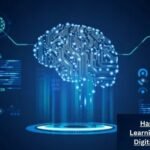The world of technology today runs on smart decisions made by computers, but how do they learn? Knowing the difference between deep learning vs machine learning is the most important step in understanding truly intelligent systems. While all deep learning is technically machine learning, the way they work and the problems they solve are completely different. For instance, deep learning is needed for teaching a car to drive itself, but simpler machine learning is enough to recommend a movie on Netflix.
This guide, written by someone who uses both of these tools every day, will break down the main ideas. You will clearly understand the difference between machine learning and deep learning, how they work, and when you should choose one over the other for real-world projects.
What Machine Learning Is
Machine learning (ML) is a method that teaches computers to learn using data. The computer looks for patterns in a huge set of examples. Then it uses those patterns to make smart predictions or decisions about new things it has never seen before.
Think of it like this: A regular programmer would have to write out every single rule (like, “If the photo has four wheels and headlights, call it a car”). Instead, with machine learning, the computer is simply shown thousands of labeled pictures of cars and trucks. The program then figures out the rules for itself.
How Machine Learning Works
The steps for standard machine learning are quite straightforward:
- Give it Data: You feed the computer a massive amount of already-labeled data.
- Pick the Features: This is where a human expert is needed! They must manually choose and define the important features (like color, weight, or specific measurements) that the computer should focus on. This is a crucial step.
- Train the Model: The algorithm uses these features to build a mathematical model. It keeps adjusting the model until its predictions are accurate.
- Make a Prediction: The finished model can now analyze new data and make a decision, like classifying an email as spam or not spam.
Because humans have to guide the process by defining features, this type of system is limited by human knowledge.
Types of Machine Learning
Machines learn in three main ways:
- Supervised Learning: This is the most common. The data is already labeled (e.g., “This is a cat,” “This is a dog”). The model learns to predict the correct label. It’s great for tasks like telling spam emails from good ones.
- Unsupervised Learning: The data has no labels. The model has to find hidden groups and structures on its own. This is used for grouping customers with similar buying habits.
- Reinforcement Learning: The model learns through trial and error. It gets a reward for correct actions and a penalty for wrong ones. This is often used to teach AI to play complex video games or control robots.
What Deep Learning Is
Deep learning (DL) is a much more advanced kind of machine learning. It can solve problems that are too messy or too complex for the older, traditional ML methods.
The main idea behind deep learning is that the system can learn the patterns and find the important features all by itself. It doesn’t need a human to tell it what to look for. This ability to learn features automatically is the fundamental difference between machine learning and deep learning.
How Deep Learning Works
The secret to deep learning is its structure, which tries to copy the way the human brain works. This structure is called a neural network

Instead of a human telling the program, “Look for the edges and colors,” the network has many layers that process information one after the other. Each layer learns a different level of detail.
- The Input: Takes the raw data, like the individual pixels of a picture.
- The Hidden Layers (This is the “Deep” Part): The data goes through many, sometimes dozens, of hidden layers. The first layers learn simple things like edges and lines. The middle layers combine those lines into shapes (like eyes or a nose). The final layers recognize the full object (e.g., a face).
- The Output: Gives the final answer or classification.
Because of these many layers, the system can handle very messy, huge datasets like complex audio, streaming video, and massive documents.
Neural Networks and Their Role in Deep Learning
It’s easy to confuse the terms neural network vs machine learning. A neural network is just the structure that makes deep learning possible.
A simple neural network can be used in basic machine learning. But when you stack many, many of these layers on top of each other—often 10, 20, or even 100 layers deep—it becomes a deep neural network. The name “deep learning” literally comes from these deep stacks of hidden layers.
Deep Learning vs Machine Learning: Key Differences
To really understand the difference between ml and dl, focus on these four main points.
| Feature | Machine Learning (ML) | Deep Learning (DL) |
| Data Feature Extraction | Manual. A human expert identifies the features (what the computer should focus on). | Automatic. The deep network learns what the important features are on its own. |
| Data Size Requirement | Works well with small to medium-sized datasets. | Requires massive amounts of data (Big Data) to work well. |
| Hardware | Can run just fine on standard CPUs. | Requires high-performance GPUs (Graphics Processing Units) for training. |
| Training Time | Usually finishes training in minutes to hours. | Can take hours to weeks to train complex models. |
If I had to summarize the debate on deep learning vs machine learning, I would say this: standard ML needs humans to tell it what to look for, while DL figures out what to look for all by itself.
AI vs Machine Learning vs Deep Learning: How They Relate
It’s easy to mix up these terms! The easiest way to think about it is like this—imagine a set of nesting dolls:
- Artificial Intelligence (AI): This is the biggest concept. It’s the overall goal of making machines think and act like humans. Example: A robot that can carry objects and talk.
- Machine Learning (ML): This is a subset of AI. It is a specific approach that lets a machine become intelligent by learning from data, rather than being told every single rule. Example: An algorithm that learns to detect a specific object.
- Deep Learning (DL): This is a subset of ML. It is a powerful method inside machine learning that uses deep neural networks to learn patterns directly from massive datasets. Example: The algorithm learns to identify and track that object in a live video stream, even if the light changes.
Deep Learning as a Subset of Machine Learning
The statement “deep learning is a subset of machine learning” is 100% correct. Every deep learning model is a machine learning model, but a regular ML model is not a deep learning model. Deep learning is just a very specific, super-charged technique within the bigger world of machine learning.
Benefits and Limitations of Machine Learning
Benefits of Machine Learning (ML)
- Less Data is Needed: ML models can be trained successfully even if you only have a few hundred or a few thousand examples.
- Faster Training: Because the models are simpler than DL, they train very quickly. This saves time and computing power.
- You Can See Inside: It is usually much easier to understand why an ML model made a decision. This is important for things like legal or financial decisions.
Limitations of Machine Learning (ML)
- Needs Human Help: It needs human experts to spend time manually selecting the best features for the model to learn from.
- Struggles with Complex Things: It cannot easily handle unstructured data like images, audio files, or complex text without a lot of manual preparation first.
Benefits and Limitations of Deep Learning
Benefits of Deep Learning (DL)
- Handles Messy Data: It is perfect for handling unstructured data like raw pixels, sound waves, or huge amounts of text directly.
- Automatic Learning: It learns the most important features all by itself, which is a huge time-saver.
- Best Results: It currently gives the best, most accurate results for many tough tasks, especially recognizing images and translating languages.
Limitations of Deep Learning (DL)
- Massive Data Thirst: You need millions of data points for it to work well. This is a huge commitment.
- Slow and Expensive: Training takes a very long time and requires powerful, expensive hardware (GPUs).
- The “Black Box”: It can be very difficult to understand how a deep neural network arrived at a particular answer.
How to Choose Between Machine Learning and Deep Learning
The choice between ml vs dl should depend entirely on your project’s data and requirements. Don’t use a hammer when you need a screwdriver!
- Check Your Data Size: If you have a small, clean, structured dataset (like a spreadsheet of customer ages and income), standard machine learning is best. If you have millions of unorganized images, videos, or raw text, you absolutely need deep learning.
- Check Your Budget: If you only have standard server computers, stick with simpler ML. If you have access to powerful, expensive GPU clusters, DL is an option.
- Check for Explanation: If your project requires a clear explanation for every decision (like a bank denying a loan), the transparency of standard ML is often the safer, better choice.
Real-World Applications Across Industries
Examples of Machine Learning Applications
- Spam Filters: Uses supervised ML to check simple features (like sender address and keywords) to decide if a message is spam or not.
- Credit Card Fraud: Analyzes simple transaction features (location, amount, time) to flag unusual spending activity instantly.
- Website Search Ranking: Uses ML algorithms to determine the importance of different web pages based on links and keywords.
Examples of Deep Learning Applications
- Self-Driving Cars: Uses deep networks to process live video and instantly identify pedestrians, traffic signs, and other vehicles in real-time.
- Voice Assistants: Use deep recurrent neural networks (RNNs) to understand and process human speech (like Siri or Alexa).
- Medical Diagnosis: Analyzes complex X-ray images or MRI scans to find very subtle patterns that might show diseases like cancer. These systems are now sometimes more accurate than human doctors!
Future Outlook for ML and DL
The future shows both machine learning and deep learning becoming much easier to use.
The trend for ML is making it more accessible. Tools are being developed so that people without deep coding skills can build powerful ML models (AutoML).
For DL, the focus is on making the models less data-hungry and less like a “black box.” Newer structures, like the huge Generative AI models we see now, are pushing the boundaries of what computers can create, not just what they can classify. It’s an exciting time!
Conclusion
The distinction between deep learning vs machine learning is crucial for anyone building intelligent systems today. Machine learning provides a reliable, efficient framework for solving the most common business problems. Deep learning provides the unparalleled power needed to handle the world’s most complex, unstructured data problems, from image recognition to autonomous control.
Both technologies work together under the umbrella of AI to drive innovation. Understanding the difference between deep learning and machine learning is the first step toward harnessing this power.
Frequently Asked Questions
Is Deep Learning better than Machine Learning?
Not necessarily. Deep learning is a subset of machine learning. It is only better for tasks that involve huge amounts of unstructured data (images, text) where it can automatically find complex features. For simpler tasks, standard ML is often faster and much cheaper.
What is the main difference between ML and DL?
The main difference between ml and dl is feature extraction. In ML, a human manually tells the model which features to look at. In DL, the deep neural network learns and extracts the important features automatically.
What is the role of the neural network in Machine Learning?
A neural network is a key structure. While simple neural networks can be used in basic machine learning, a deep neural network (one with many layers) is what defines the specialized field of deep learning.
How do AI, Machine Learning, and Deep Learning relate?
AI is the overall, biggest goal (making machines intelligent). Machine learning is the main method to achieve that goal (learning from data). Deep learning is a specific, powerful technique within machine learning (using deep neural networks).
Sources & References
- https://cloud.google.com/discover/deep-learning-vs-machine-learning (Google Cloud, AI and ML Discovery, 2024)
- https://aws.amazon.com/compare/the-difference-between-machine-learning-and-deep-learning/ (AWS, Data Technologies Comparison, 2024)
- https://www.ibm.com/think/topics/ai-vs-machine-learning-vs-deep-learning-vs-neural-networks (IBM, AI and Technology Concepts, 2024)
- https://www.mdpi.com/2073-431X/12/5/91 (MDPI, Machine Learning and Deep Learning Architectures, 2024)
- https://ischool.syracuse.edu/deep-learning-vs-machine-learning/ (Syracuse University’s iSchool, Deep Learning Differences, 2025)
- https://www.tableau.com/learn/articles/machine-learning-examples (Tableau, Real-World Machine Learning Examples, 2025)
- https://research.aimultiple.com/deep-learning-applications/ (AIMultiple Research, Top Deep Learning Use Cases, 2024)
- https://www.mygreatlearning.com/blog/deep-learning-applications/ (Great Learning, Top Deep Learning Applications, 2025)










